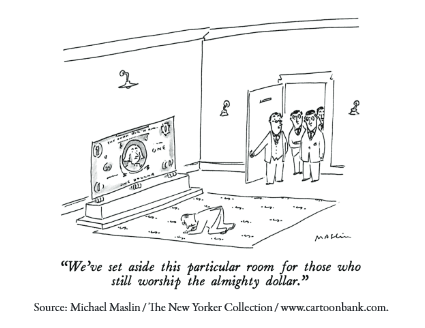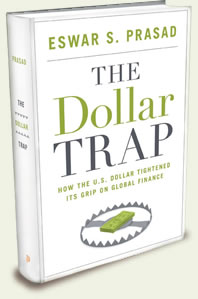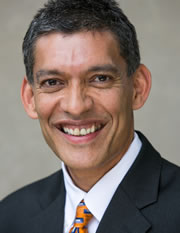Preface
The U.S. dollar reigned supreme in global finance for most of the twentieth century. In recent years, its position on that pedestal has seemed increasingly insecure. The creation of the euro in 1999 constituted a major challenge to the dollar, but that challenge has faded. Now the Chinese renminbi is seen as a rising competitor.
The global financial crisis, which had its epicenter in the U.S., has heightened speculation about the dollar’s looming, if not imminent, dis-placement as the world’s leading currency. The logic seems persuasive. The level of U.S. government debt relative to gross domestic product (GDP) is at its highest point since World War II and could soon be back on an upward trajectory. America’s central bank, the Federal Reserve, has taken aggressive actions to prop up the economy by injecting massive amounts of money into the U.S. financial system. Moreover, it is apparent to the entire world that political dysfunction in the U.S. has stymied effective policy making. All these factors would be expected to set off an economic decline and hasten the erosion of the dollar’s importance.

Contrary to such logic, this book makes the argument that the global financial crisis has strengthened the dollar’s prominence in global finance. The dollar’s roles as a unit of account and medium of exchange might well erode over time. Financial market and technological developments that make it easier to denominate and conduct cross-border financial transactions directly using other currencies, without the dollar as an intermediary, are reducing the need for the dollar. In contrast, the dollar’s position as the foremost store of value is more secure. Financial assets denominated in U.S. dollars, especially U.S. government securities, are still the preferred destination for investors interested in the safekeeping of their investments.
The dollar will remain the dominant reserve currency for a long time to come, mostly for want of better alternatives. In international finance, it turns out, everything is relative.
Structure of the Book
The book intersperses analytical and narrative elements and is divided into four parts.
Part One: Setting the Stage
The first part summarizes the arguments that underpin the book’s thesis. The Prologue (Chapter 1) describes how certain dramatic developments in global financial markets since 2008 have played out in a curious and unanticipated manner. The sequence of economic events runs directly counter to the expected course for a country whose financial markets were imploding and whose economy was heading into a deep and pro-longed recession.
The main themes of the book are laid out in Chapter 2. It explains the origins and resilience of the dollar’s status as the principal reserve currency in the post–World War II era. The dollar has survived various threats to its dominant role in the global monetary system, allowing the U.S. to continue exploiting its “exorbitant privilege” as the purveyor of the most sought-aft er currency in global finance. Foreign investors are keen to invest in financial assets denominated in U.S. dollars, allowing the U.S. government and households to maintain high levels of consumption through cheap borrowing.
The large scale of borrowing from abroad, signified by massive U.S. current account deficits, is in fact a relatively recent phenomenon. It coincides with the latest wave of financial globalization—the surge in international financial flows—that got under way in earnest in the early 1990s. These phenomena turn out to be interrelated. Rising cross-border capital flows, particularly to and from emerging market economies, play a central role in the story told in this book.
Part Two: Building Blocks
The second part provides a guided tour through some key analytical concepts that are necessary to underpin any analysis of the international monetary system.
I identify various paradoxes in the present structure of international finance that serve as the ingredients for the book’s main thesis.
Chapter 3 sketches out the main elements of a standard framework that economists use to study international capital flows, and illustrates how and why the data refute it in many ways. For instance, the theory predicts that capital should flow from richer to poorer economies, whereas the reality has been the opposite. Even though one of its main predictions is refuted by the data, the framework provides a useful benchmark for exploring deficiencies in the present setup of global finance. This necessitates a more careful investigation of the direction, composition, and volatility of capital flows. These topics have taken on greater significance as financial markets around the world continue to become more tightly linked to one another.
Indeed, the global financial crisis has not deterred even the emerging market economies, which once had extensive restrictions on capital flows, from allowing freer movement of financial capital across their borders. Chapter 4 analyzes how rising integration into global financial markets has affected these economies’ external balance sheets (i.e., their asset and liability positions relative to the rest of the world). Emerging markets have been able to alter the profile of their external liabilities away from debt and toward safer forms of capital inflows, such as foreign direct investment. Still, even as their vulnerability to currency crises has declined, these economies face new dangers from rising capital flows, including higher inflation as well as asset market boom-bust cycles fueled by those flows.
In Chapter 5, I turn to the growing importance of “safe assets,” investments that at least protect investors’ principal and are relatively liquid (i.e., easy to trade). Rising financial openness and exposure to capital flow volatility have increased countries’ demand for such assets even as the supply of these assets has shrunk. Emerging market economies have a stronger incentive than ever to accumulate massive war chests of foreign exchange reserves to insulate themselves from the consequences of volatile capital flows. The global financial crisis shattered conventional views about the level of reserves that is adequate to protect an economy from the spillover effects of global crises. Even countries that had a large stockpile found their reserves shrinking rapidly in a short period during the crisis, as they strove to protect their currencies from collapse. So now the new cry of policymakers in many emerging markets seems to be:
We can never have too many reserves.
Additionally, many of these countries, as well as some advanced economies like Japan, have been intervening heavily in foreign exchange markets in order to limit appreciation of their currencies, thereby protecting their export competitiveness. Exchange market intervention results in the accumulation of reserves, which need to be parked in safe and liquid assets, generally government bonds. Moreover, at times of global financial turmoil, private investors add to the demand for safe assets.
With its deep financial markets, the U.S. has become the primary global provider of safe assets. Government bonds of many other major economies—such as the euro zone, Japan, and the U.K.—look shakier in the aftermath of the financial crisis, as these economies contend with weak growth prospects and sharply rising debt burdens. As a result, the supply of safe assets has fallen even as the demand for them has surged. Official and private investors around the world have become dependent on financial assets denominated in U.S. dollars, mainly because of the lack of viable alternatives. U.S. Treasury securities, representing borrowing by the U.S. government, are still seen as the safest of financial assets worldwide. Therein lies the genesis of the dollar trap.
Does it make sense for other countries to buy increasing amounts of U.S. public debt, when the amount of that debt is ballooning rapidly and could threaten U.S. fiscal solvency? In Chapter 6, I make the case that foreign investors, especially the central banks of China and other emerging markets, are willing participants in an ostensible con game set up by the U.S. Foreign investors hold about half of the outstanding U.S. federal government debt. The high share of foreign ownership should make it a tempting proposition for the U.S. to cut its debt obligations simply by printing more dollars, thus reducing the value of that debt and implicitly reneging on part of the obligations to its foreign investors. Of course, such an action is unappealing, as it would push up inflation and affect U.S. investors and the U.S. economy as well.
I argue that there is a delicate domestic political equilibrium that makes it rational for foreign investors to retain faith that the U.S. will not inflate away the value of their holdings of Treasury debt. Domestic holders of U.S. debt constitute a powerful political constituency that would inflict a huge political cost on the incumbent government if inflation were to rise sharply. This gives foreign investors some reassurance that the value of their U.S. investments will be protected.
But China and other countries are still frustrated that they have no place other than dollar assets to park most of their reserves. This frustration is heightened by the disconcerting prospect that, despite its strength as the dominant reserve currency, the dollar is likely to fall in value over the long term. China and other key emerging markets are expected to continue registering higher productivity growth than the U.S. Thus, once global financial markets settle down, the dollar is likely to return to the trend of gradual depreciation that it has experienced since the early 2000s.
In other words, foreign investors stand to get a smaller payout in terms of their domestic currencies when they eventually sell their dollar investments. This is a price foreign investors seem willing to pay to hold assets that are otherwise seen as safe and liquid. Financing continued fiscal profligacy in the U.S. stings.
Part Three: Inadequate Institutions
As national economies become more closely connected with one another, there is greater potential for both conflict and cooperation. Which of these two paths is taken has implications for the global configuration of reserve currencies. The third part of the book illustrates how existing frameworks for international economic cooperation have not worked well, leaving conflict rather than cooperation as the more typical state of affairs. This part of the book takes the reader on a behind-the-scenes tour of some of the intrigue in international financial diplomacy, using a variety of sources and even drawing on unconventional sources, such as Wikileaks cables.
Economic tensions among countries are being heightened by the proclivity of the U.S. and other advanced countries to use unconventional monetary policies aggressively—in effect, printing large amounts of money—to prop up their economies and financial systems. These measures have the side effect of depreciating their currencies. Currency depreciation is a zero sum game—if one currency depreciates, some other currency has to appreciate. Hence, actions taken by some major central banks have set off a spate of currency wars as other countries take steps to prevent their own currencies from appreciating. In Chapter 7, I examine the rhetoric and substance behind currency wars. Ironically, when countries resist currency appreciation through intervention in foreign exchange markets, which adds to their foreign exchange reserves, they end up reinforcing the dollar’s prominence as a reserve asset.
One concern is that currency wars could end up becoming a more destructive negative sum game in which all players get hurt. If countries’ actions aimed at promoting their own short-term interests end up impeding international trade and financial flows, no country will escape from the negative consequences. Coordinated collective action is therefore in the long-term interest of all countries. In Chapter 8, I trace out how one attempt to mediate a global truce on currency tensions—during an episode that preceded the global financial crisis—fell apart. For all their positive rhetoric, national leaders were unable to put collective interest before the parochial interests of their own countries. This episode illustrates that although global coordination of certain economic policies seems desirable in principle, it has proven elusive in practice.
The goal of coordinating policies was revived during the worst of the global financial crisis through the efforts of the Group of 20, comprising the major advanced and emerging market economies. Chapter 9 describes how this large and diverse group did manage some notable accomplishments in the crucible of the crisis, but the spirit of cooperation ultimately proved fleeting. To break free of the dollar, emerging markets have tried various forms of coordination among themselves, but success has been elusive on that front as well.
With their backs against the wall, some emerging markets have tried to use temporary capital controls—legal restrictions on inflows of capital into and outflows of capital from their economies—to protect themselves from the onslaught of volatile capital flows. Chapter 10 provides a survey of how the debate on capital controls has shift ed. Such controls have be-come more palatable, as they are no longer seen as violating international norms if there are extenuating circumstances, such as fears that a country’s banking system or equity markets are in danger of being overwhelmed by inflows of foreign capital. However, this self-defense mechanism turns out not to work very well in practice. This leaves emerging markets with few options to protect themselves other than building up ever-larger stocks of foreign exchange reserves that can be deployed as buffers against capital flow and currency volatility.
In Chapter 11, I review some attempts to create global safety nets that would offer protection from crises and other episodes of extreme volatility, thereby reducing countries’ incentives to self-insure by accumulating foreign exchange reserves. The International Monetary Fund (IMF) has created new lending programs, with guaranteed access to money in bad times. These programs are meant to function more like insurance schemes, rather than as traditional loan programs that require countries to meet tough policy conditions. There have been few takers for these insurance schemes, perhaps because there is a stigma attached to preemptively seeking the IMF’s assistance.
Of course, the IMF is not the only game in town. During the financial crisis, the U.S. Federal Reserve offered a few foreign central banks access to dollars. Those central banks were then able to provide dollars to commercial banks in their countries that suddenly found themselves deprived of dollar funding. But such ad hoc lines of credit are nowhere near enough to meet the global demand for dollars.
Because these attempts at obviating the need for self-insurance by individual countries have not proven successful, I briefly summarize a proposal for a simple global insurance scheme that would solve many conceptual problems that have bedeviled other collective approaches. However, the world does not yet appear ready for a proposal that is technically simple but could shake up existing institutional structures. The clutches of the dollar trap remain sticky.
Part Four: Currency Competition
The final part of the book evaluates potential competitors to the dollar and sums up the dollar’s prospects. Countries’ desire for insurance through accumulation of safe assets, and the ability of the U.S. to provide purportedly safe assets in prodigious amounts that meet the demand, suggest that the dollar’s position is secure. Still, there are competitors to the dollar that are beginning to flex their muscles.
Chapter 12 critically evaluates the much-hyped prospects of China’s currency, the renminbi, displacing the dollar. China is already the second-largest economy in the world and is on track to become the world’s largest economy within the next decade. The Chinese government is taking aggressive steps to promote the international use of its currency. This chapter makes the case that the renminbi is on its way to becoming a viable reserve currency.
However, the limited financial market development and structure of political and legal institutions in China make it unlikely that the renminbi will become a major reserve asset that other countries turn to for safekeeping of the bulk of their reserve funds.
The renminbi is hardly the only currency with aspirations of playing a more prominent role on the world stage. Chapter 13 reviews the prospects for other currencies, as well as alternatives such as gold and bit-coins, to threaten the dollar. With greater integration of global financial markets and rapid technological advancements, it will become easier to settle cross-border trade and financial transactions in currency pairs that do not include the dollar. The main conclusion from Chapters 12 and 13 is that the dollar is likely to become less important as a medium of exchange for mediating international transactions. But its position as a store of value remains secure for the foreseeable future.
Although this book presents more reasons to be sanguine than concerned about the dollar’s future, the global monetary system is at a fragile equilibrium. Chapter 14 analyzes various tipping point scenarios that could cause the dollar to come tumbling down from its pedestal. A few such scenarios are plausible, but there is no easy escape route from the dollar, as financial turmoil even in its home country will simply drive investors back into its arms.
Chapter 15 points out that, in addition to its size and the strength of its financial markets, the U.S. enjoys advantages that most other countries can only aspire to. These advantages include the robustness of its public, political, and legal institutions, along with a strong and self-correcting system of checks and balances among these institutions.
The threads of argument in the book converge to a conclusion that the dollar will continue to reign as the leading reserve currency for many years to come. This dollar-centric equilibrium seems to be unstable, with big risks for the entire world economy. The very fear of the devastation that would be wrought if it were to fall apart might, paradoxically, serve to make this equilibrium a stable one.
I leave it to the reader to decide whether the book’s conclusion is a comforting or disturbing one.
© Copyright, Princeton University Press. No part of this book may be distributed, posted, or reproduced in any form by digital or mechanical means without prior written permission of the publisher.

